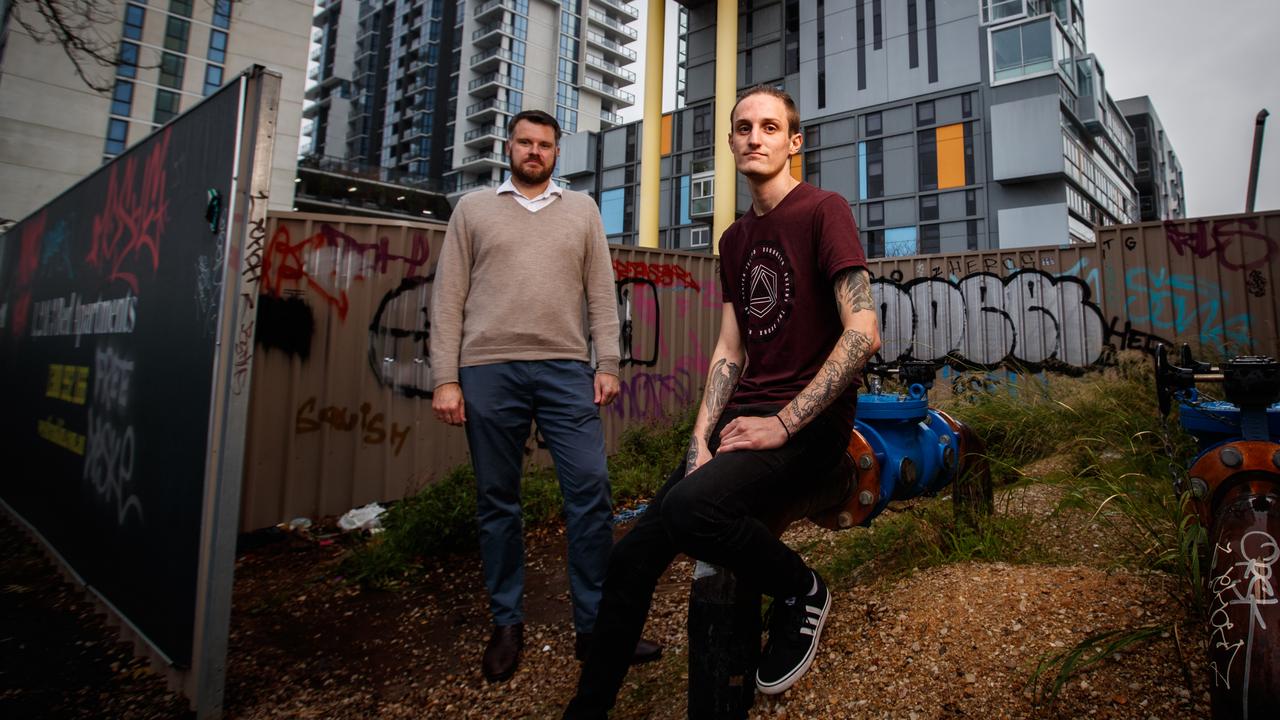How SA put some of Australia’s classic cars on the road to glory.
TWO of the hottest cars in Australia’s Ford v Holden history came out of South Australia while a stretch of rough road near Port Lincoln became the testing ground for Ford’s XM protoypes
SA Weekend
Don't miss out on the headlines from SA Weekend. Followed categories will be added to My News.
IT’S a wide brown land to break the hearts of drivers and the reputations of their cars. Now a new book has put together a list of the 50 most influential cars in our history, the ones that lasted and the ones that didn’t, from success stories like the Ford Explorer and Holden’s Commodore to shockers like Leyland’s P76.
It’s a roll call that will have motoring fans travelling high speed down memory lane, with the VW Kombi (making a comeback), Subaru’s impressive Brumby ute (some still going), Holden’s Sandman panel van (if you see me rockin’, don’t bother knockin’), and Toyota’s LandCruiser (which gave Land Rover a lesson in reliability).
But we’ve chosen three classics which can all claim to be made, at least in part, in SA – there’s the Valiant Charger at No. 29, Holden EH at No. 32, and Falcon XM at No. 35.

HOLDEN EH
1964. THE BEATLES WERE IN TOWN. THE ECONOMY WAS BOOMING. AND DRIVING THE GREAT AUSTRALIAN DREAM WAS A HOLDEN WITH LOOKS AND SMARTS.
A record 156,000 examples of “Australia’s own” car were sold in 1964 and more than 250,000 in the first 18 months. It’s an incredible achievement and demonstrates just how powerful Holden was at the time, even in the face of increasing competition from Ford and Chrysler.
The EH wasn’t even an all-new model. It was a tasteful facelift of the EJ, blessed with a new generation of engines that put Holden back on top of the performance pile. This was the legendary “red” motor, the inline six-cylinder that would trace its way through the decades as far as Commodore models of the 1980s.
Holden used it to good effect in EH, the 179 cubic inch (2.9-litre) version making a heady 86 kW and forming the basis of the S4 racing version, which finished second in the Bathurst 500. The higher performance of the EH clearly captured the interest of a nation riding high on a strong economy and optimistically looking to a bright future.
The EH had its issues; even the S4 was fitted with all-round drum brakes and they weren’t all that effective. But there was an EH for everyone, starting with the Standard sedan, then came the Special and the Premier, the latter a new luxury model introduced with EJ. There were also wagon, panel van and utility body styles.
Today the EH is still admired for its good looks, yet it’s little known that this was one Holden over which Australians had no styling influence. Unhappy with the direction local design attempts were headed, General Motors in Detroit took over the facelift. The car simply turned up at Holden in a crate.
No surprise, Holden didn’t publicise that fact about Australia’s car!

FORD FALCON XM 1964
WHILE THE XK WILL ALWAYS BE CELEBRATED AS THE FIRST FORD FALCON TO BE BUILT IN AUSTRALIA, IN 1960, IT WAS THE XM THAT WAS THE FIRST TRULY AUSTRALIAN FALCON.
In the memorable words of one long-retired Ford engineer, the XK “was a heap of shit” – a US market compact sedan pressed into service without much testing or modification as the blue oval’s frontline six-cylinder competition for the all-conquering Holden. The car literally collapsed on Australia’s much rougher roads.
To its credit, Ford in the US bit the bullet and authorised £1 million ($2m) to upgrade the Falcon XM, due for sale in 1964, and another £750,000 ($1.5m) to develop a proving ground on the outskirts of Geelong in the You Yangs range.
The XM would go on sale long before the development centre was completed, so where could Ford Australia quietly conduct a major testing and development program in the winter of 1963 on typical Australia roads away from prying eyes?
The answer was the tuna-fishing town of Port Lincoln on the tip of Eyre Peninsula in South Australia. It came to Ford’s attention as a testing location because the local dealer, Blacker Motors, was sending in so many warranty claims against the XK and its successor the XL. The roads there must be tough, then!
While Australians welcomed monarch Queen Elizabeth II for her second state visit and celebrated Margaret Court’s Wimbledon win, Ford testers quietly got on with the job of resuscitating the Falcon. Six drivers and mechanics drove 1000-mile days on a 500-mile route for weeks, working in shifts to thrash two XM prototypes. They mostly frequented the rough and tumble roads close to Port Lincoln at Cape Catastrophe, named by explorer Matthew Flinders in 1802 when eight of his crewmen drowned nearby.
There’s no doubt the testing resulted in a huge number of important modifications to the XM – and at the time Ford claimed 1500.
To ensure the message got across to Australians, Ford flew 50 journalists in to the launch of the XM in Port Lincoln, on the roads of Cape Catastrophe.
“The new Ford Falcon can add another label to its ‘Made in Australia’ tag . . . it’s now designed and tested here as well,” wrote Trevor Davis of The Age. And that was the story for every Falcon that came after it until production ended in October 2016.

CHRYSLER VALIANT CHARGER 1971
THE DRIVE OF CHOICE FOR CINEMA SEX-GOOF ALVIN PURPLE, THIS CHARIOT OF FIRE BECAME A MEDIA SUPERSTAR VIA THE ‘HEY CHARGER’ AD CAMPAIGN FEATURING FUTURE OSCAR WINNER GEOFFREY RUSH.
Adding even more lustre were the R/T (Road/Track) E38 and E49 high performance versions which took on the underdog role fighting the factory teams from Holden and Ford at Bathurst.
The Charger was a classic amalgam: American-inspired exterior design jigsawed together using bits and bobs from various local Chrysler models, then built in Adelaide for Australians.
Based on a shortened version of the Valiant sedan platform, it was designed to deliver Chrysler Australia a slice of the then sizeable two-door sports coupe market against the likes of the Holden Monaro and Ford Falcon Hardtop. But the Charger quickly did more than that. Maybe it even deserves that overused term “icon”. Low-slung good looks, attractive pricing and strong performance were just part of the story.
The Charger first appeared in August 1971 as part of the VH Valiant range and it caught the mood of a rapidly evolving Australia.
An era of conservative rule was reaching its end; “Make love not war” the banners urged as hundreds of thousands marched in the streets protesting our involvement in Vietnam; flower power was in, rock ‘n’ roll was in, drugs were in. It was time for change. Time for something new.
The Charger was an instant sales success, quickly climbing to account for 50 per cent of all Valiant sales, leaving the balance for the sedans and wagons to split between them.
“There can be no denying that the Charger is the most handsome car Chrysler has produced and probably the best looking ever produced by an Australian manufacturer,” wrote Australian Motoring News.
The year was topped off by Charger winning the prestigious Wheels Car of the Year prize. By now, demand had dictated that production at the Chrysler plant in Adelaide had more than quadrupled from 20 to 83 cars per day.
It shows how different attitudes to cars were back then that the Charger’s five-seat arrangement ensured it lots of family buyers, even though it was only a two-door.
There were four Charger models launched initially, the cheapest of them undercutting the four-door Valiant sedan on price. This was an unusual ploy considering coupes are normally more expensive than their mainstream relations.
The Charger line-up included inline six-cylinder and V8 models. There were some weak points; the manual sixes made do with an old three-speed transmission and the base model had drum brakes all round. But it was R/T E38 and then the E49 that were the headline grabbers, specifically designed to go up against the GTHO Phase III Falcons and GTR-XU1 Toranas in racing.
Powered by a bored-out and fortified 4.3-litre Hemi engine fitted with three dual-throated Weber carburettors – prompting the “6 Pack” sticker on the car – the E38 produced 210kW.

Bathurst 1971 proved the E38 wasn’t fast enough or reliable enough to take on the Holdens and Fords, so Chrysler went back to the workshop and produced the greatest Charger of them all, the E49.
A Borg-Warner four-speed replaced the ancient three-speed and the engine was boosted to 226kW. Acceleration numbers were stunning: 0–100km/h in 6.1 seconds and the standing 400 metres in 14.5 seconds. It took another 20 years for a locally built Australian six-cylinder road car to go faster.
The E49 delivered Chrysler third and fourth place in the 1972 Bathurst 500, but the high-water mark had been reached. The early 1970s “Supercar scare”, prompted by a Sydney Sunday newspaper article, played a big role in Chrysler’s decision to abandon plans for a V8 racing Charger, drop the R/T program and pull out of motorsport.
In 1973, there was a minor overhaul of the Charger as part of the VJ Valiant update, but it didn’t reverse a downward trend in two-door sales. The 1975 VK was no more significant and by 1976 just two Chargers models were left in the line-up.
Chrysler was struggling for sales. The first fuel crisis was biting hard and by 1976 it had abandoned thoughts of a new-generation Valiant range. Instead, a sheet metal overhaul dubbed CL was introduced and Charger was reduced to just one model, the 770.
Clearly Chrysler had lost interest in the Charger. Instead, it was chasing sales with the new Valiant panel van and the Sigma small car sourced from Mitsubishi.
When handling became a big thing in 1978 – remember Holden’s Radial Tuned Suspension? – Chrysler overhauled the underpinnings of most of its big cars, yet didn’t touch the Charger, its most sporting model.
The Charger, which had caused so much sensation and captured so much attention, ended its run quietly in October 1978. All-up 31,857 had been built.
Chrysler Australia soon went the same way, with Mitsubishi buying the company from its US parent in 1980 and taking over Adelaide manufacturing operations.
Extracted from Kings of The Road by Toby Hagon & Bruce Newton, published by Pan Macmillan, RRP$49.99. Available in book stores from June 26.


